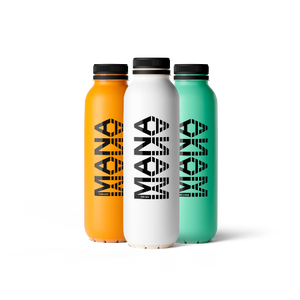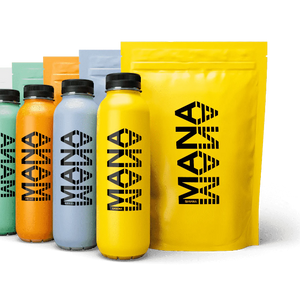blogs
september 7 2022
Studying, Homework, Courses and Big Dreams... With Mana, Kids Have Enough Energy to Reach for the Stars! Already From the Age of 3!

Are you hesitant to include Mana in your child's diet? You certainly don't have to be... It is important to establish good eating habits in children that will influence them for the rest of their lives and to ensure a varied and regular diet. With Mana, you'll give your children all the nutrients they need to be able to concentrate better and have enough energy to reach for the stars! Why is Mana suitable for children from 3 years old? And how much Mana can they have every day?
There is so much information about how to properly set the nutrition of the child that one often gets lost in it. What or how much should children actually eat? It is important to guide your children and teenage children to eat a varied diet and to eat regularly—at least five times a day. But every child has a different genetic predisposition, a different daily routine, level of physical activity and different eating habits.
School-age children in particular have more important things to worry about than keeping track of how regularly they eat. Then they skip breakfast, but sometimes also lunch. However, irregular eating can lead to poor concentration, lack of energy and fatigue at school or when studying, or overeating in the evening and potentially disrupting metabolism. We cannot be surprised if our child then gains weight. And this can then result in obesity and, in the long term, the development of insulin deficiency and type II diabetes.
Mana can be included in your child's diet from the age of 3
Whether it's an adult or a child's diet, a balanced ratio of macronutrients (proteins, fats, carbohydrates) and micronutrients (vitamins and minerals) is essential. For a child's body to function normally and perform all its vital functions, it needs energy, which is supplied mainly by carbohydrates or sugars and partly by high-quality fats and proteins. With regard to vitamins and minerals, the importance of calcium and vitamin D for optimal bone growth in children is well known. In adolescence, B vitamins are essential for proper energy metabolism. Vitamins A, C, E, K1, K2 and other nutrients, including phytonutrients, are also important.
Thanks to thorough testing, quality ingredients and processing technology, we have been able to develop a product that is nutritionally complex enough to be safely consumed by children as young as 3 years old. What's more, they can also benefit from it. Mana provides them with absolutely everything they need without any unsuitable or harmful ballast. However, in order to get an objective picture, below we take a closer look at the composition of Mana and the role it plays in children's nutrition.

Protein is essential for the formation of the body's tissues
It may not seem like it, but for the optimal development of the child, proteins are also important. They are necessary primarily for the formation and renewal of the body's tissues. They also ensure the transport of substances, are needed for the synthesis of compounds with specific functions and are used as a source of energy.
Protein deficiency can not only cause problems in growth and development, but it can reduce immunity and slow regeneration of the body after sports activity. The amount of protein that any given child needs per day depends on their age, gender, and level of physical activity. On average, they need about 1-1.5 g of protein per kilogram of body weight.
ManaPowder delivers 21 grams of protein per serving while ManaDrink delivers 17 g per serving. This means that 2-3 ManaDrinks per day can cover the protein needs of nearly every child, regardless of gender or level of physical activity. There are 6 sources of protein in Mana: isolated soy and pea protein, oat protein, pumpkin protein, rice protein, and algae protein. Although this mixture is purely plant-based, it is comprehensive and contains all 9 essential amino acids. To read our article about plant protein vs. animal protein in the human diet, go here.




New
ManaDrink | Origin
Thanks to thorough testing, quality ingredients and processing technology, we have been able to develop a product that is nutritionally complex enough to be safely consumed by children as young as 3 years old.
BuyCarbohydrates: the corner piece of the puzzle
Important in this respect is the glycemic index of food (GI), which indicates how the carbs in a food behave in the human body after they are consumed, i.e. how quickly they break down into glucose and supply energy. The simpler the sugars in a food, the higher its GI and the greater the fluctuations in blood glucose levels after its consumption. The more complex the sugars, the lower the GI and the more gradually the energy from the food is released in our bodies.
A kid’s body needs energy in order to function normally. The majority of this energy should come from carbohydrates. Carbs should account for 45-60% of their daily energy intake and are thus indispensable to healthy growth. Nevertheless, overconsumption of carbs—especially simple carbs—can harm children just like it can adults, and lead to the development of obesity or diabetes.
Mana has a low glycaemic index, GI = 29. Foods with such properties help to regulate not only blood sugar, but also blood cholesterol (including the so-called bad LDL cholesterol), reduce the risk of developing obesity, type II diabetes and improve concentration. To illustrate, glucose or toast bread have a GI = 100, so unlike Mana, they are a heavy burden on the body.

Why are fats and unsaturated fatty acids important?
In addition to the balanced amount of macronutrients we were speaking about above, the content of healthy fats is also worth mentioning. Healthy fats help to regulate blood cholesterol and provide the body with energy and the building blocks of the child's nervous system. At the same time, fats also form cell membranes that act as carriers of certain vitamins (A, D, E, K) and antioxidants.
Mana contains a unique blend of 6 plant fats that are sources of valuable phytonutrients and fat-soluble vitamins such as phytosterols, carotenoids or vitamin E. Seaweed oil, in turn, is rich in omega-3 fatty acids, which play a key role in the growth and development of children. They promote heart and brain health, a healthy sleep and immunity. In addition, a 2015 study published in the scientific journal Neuropsychopharmacology found that taking 1300 mg of omega-3s daily improved attention in patients with and without ADHD.
A 2019 US study even linked omega-3 intake in children to a reduction in asthma symptoms caused by environmental pollution. One serving of ManaPowder contains up to 1300 mg and ManaDrink 1100 mg of omega-3 fatty acids.
Fiber: a secret weapon against child obesity
Fiber is very important for our digestion. We know soluble and insoluble fiber. Soluble fiber absorbs water in the digestive tract and forms a mucus layer that slows down the absorption of fats and cholesterol. By swelling and absorbing water in the stomach, it produces a prolonged feeling of satiety. In addition, it also acts as an intestinal prebiotic, thus feeding the body's beneficial intestinal bacteria.
Insoluble fiber cleans the intestines mechanically and speeds up the passage through the digestive tract. However, it also reduces the absorption of sugars, thus lowering the overall glycaemic index of the food. All of this has a beneficial effect on preventing childhood overweight, which is supported by the results of two 2017 US studies. These studies suggest that prebiotics help reduce body weight and subjective appetite levels.
The susceptibility of children to obesity is a huge topic in itself. In the last 30 years, obesity rates have doubled among children and tripled among adolescents in the United States. Today, around 17% of the country’s children are obese.
According to research published in 2010 in The New England Journal Of Medicine, childhood obesity can significantly increase the chances of heart disease, stroke, liver disease and cancer in adulthood. The most effective solution is to not teach children from toddlerhood to have a strong sweet and salty taste in the form of sweets and salty “junk” foods.
Yet an uncompromising ban on anything sweet and salty is not the right path to take. There are foods that will satisfy kids’ cravings, yet which are still healthy. ManaDrink Choco is one of them. It has a long shelf life and does not require any refrigeration. It can easily be thrown in a school bag and it’s ready to drink when hunger strikes.
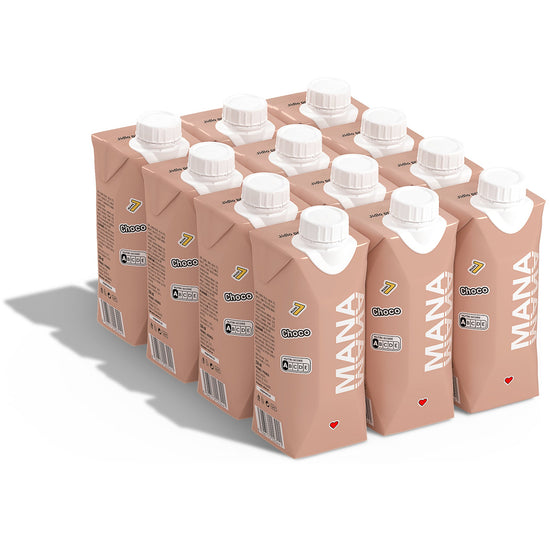
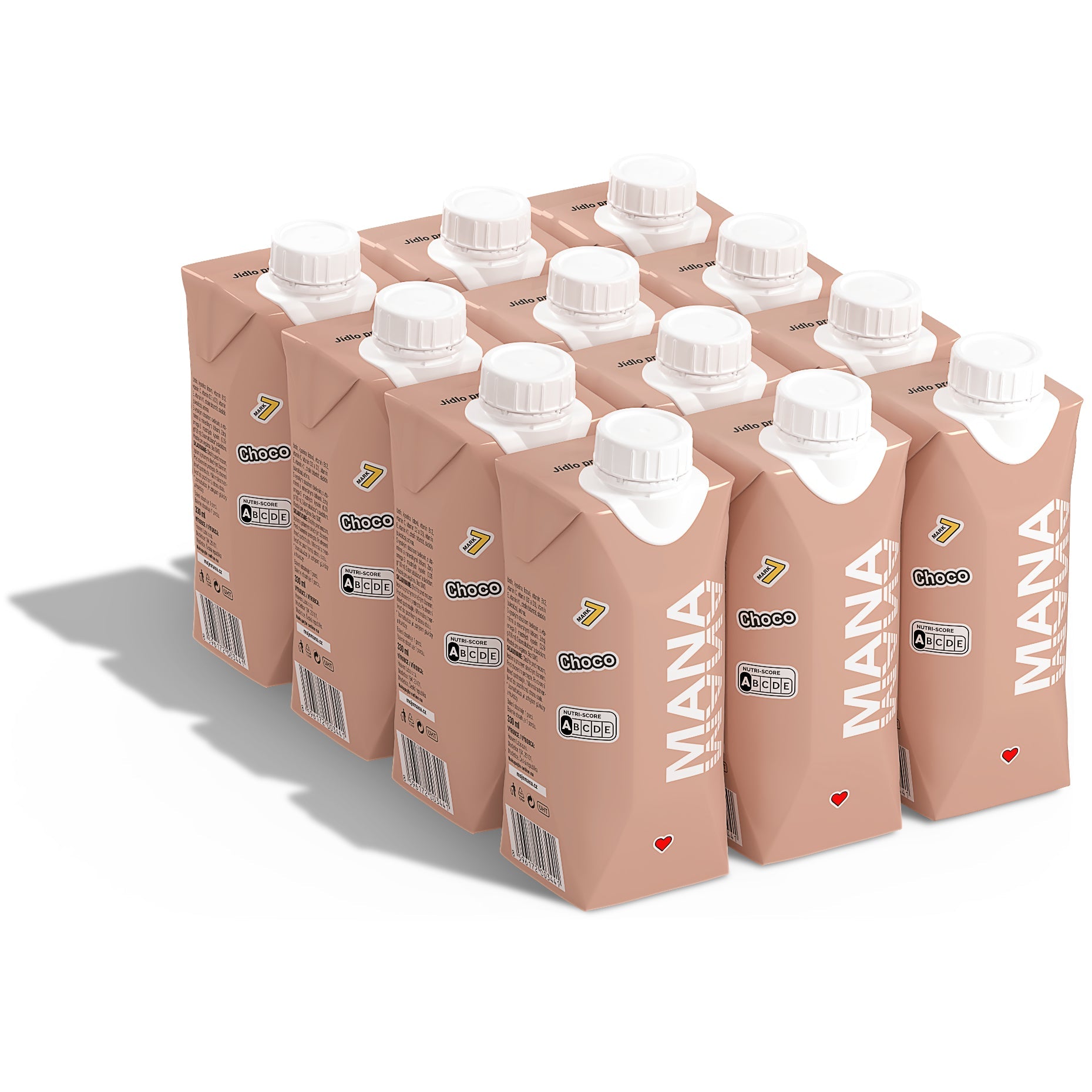

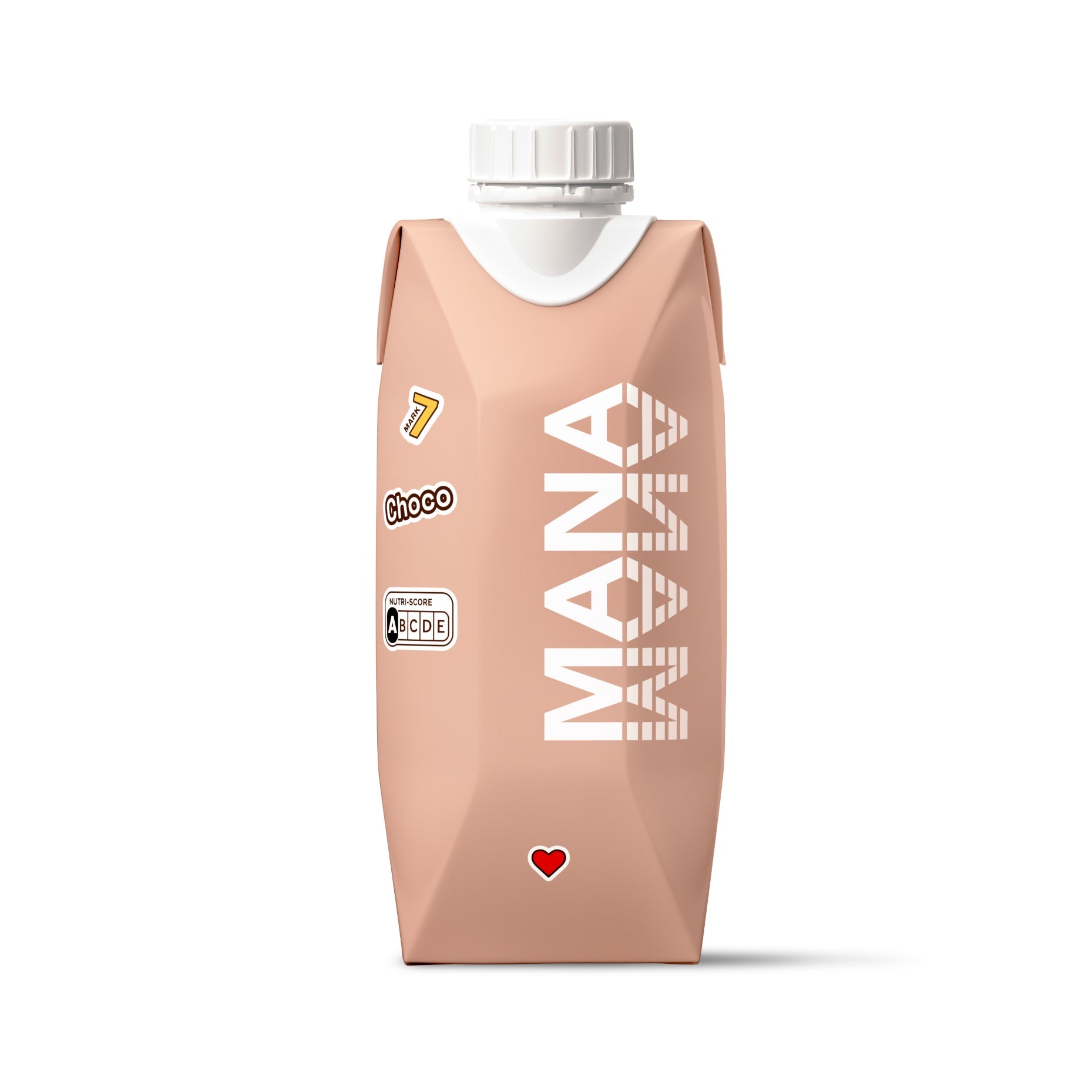
New
ManaDrink | Choco
A deliciously chocolatey and healthy snack full of protein, fiber, vitamins and minerals. The ideal solution for school children.
BuyVitamin and mineral requirements for children have changed over the years
Calcium, for example, which plays a role in bone construction, is very important for adolescents. Bone growth in both adolescent boys and girls increases their need for calcium to up to 1200 mg per day. Absorption of calcium is also related to intake of vitamin D.
Adolescent girls, in turn, should increase their intake of iron and folic acid. In addition, during adolescence, both sexes should have a higher intake of B vitamins, which are essential for proper energy metabolism. Children are also often deficient in vitamins C and A.

Vitamins are essential micronutrients, which means that the body cannot produce them on its own, so we have to get them from external sources—diet, supplements and, in the case of vitamin D, the sun. Mana contains the full spectrum of all 14 essential vitamins, including vitamin B12, which is often lacking in diets without animal ingredients.
Minerals are of course also essential for proper functioning of the human body. They play a role in the construction of tissues and are important for proper muscle and brain function. Our latest drink and powder recipe, Mark 7, contains all 17 essential minerals, including new, chelated forms of magnesium, potassium, and zinc, which are more soluble.
So how much Mana can you give your child?
Although Mana is a complete and nutritionally balanced food, it should not be a full substitute for a varied diet for children or adolescents. Yet it can serve as a full breakfast or snack instead of buffet food or sweets with added sugar.
We understand that, even after a close examination of our product labels, it can be difficult to estimate how to properly portion Mana for children. Their total daily calorie intake should support growth and development, as well as healthy body weight. But the average energy intake of children ranges from 1100 calories in younger children to 2800 calories in older adolescents. So, how to know what portions are optimal? It is not always clear.
For this reason, we have prepared exact instructions on how to portion Mana for children and adolescents by age, gender, and level of physical activity, which can be found here. The document also includes recommended daily intakes for protein, fiber, and other essential vitamins and minerals.
With Mana, you can be confident that you are giving your children the best nutrition currently available on the planet. It also makes it easy to count the ratio of all nutrients per calorie, as well as control total calorie intake.
Sources:
[1] A. C. Nicolucci, M. P. Hume, I. Martínez, S. Mayengbam, J. Walter, R. A. Reimer (2017) Prebiotics Reduce Body Fat and Alter Intestinal Microbiota in Children Who Are Overweight or With Obesity.
https://www.gastrojournal.org/article/S0016-5085(17)35698-6/fulltext?referrer=https%3A%2F%2Fpubmed.ncbi.nlm.nih.gov%2F
[2] M. P. Hume, A. C. Nicolucci, R. A. Reimer (2017) Prebiotic supplementation improves appetite control in children with overweight and obesity: a randomized controlled trial.
https://academic.oup.com/ajcn/article/105/4/790/4633966
[3] Healthline.com. Should Kids Take Omega-3 Supplements?
https://www.healthline.com/nutrition/omega-3-for-kids#benefits-for-kids
[4] D. J. Bos, Bob Oranje, E. S. Veerhoek, R. M. Van Diepen, J. MH Weusten, H. Demmelmair, B. Koletzko, M. GM de Sain-van der Velden, A. Eilander, M. Hoeksma, S. Durston (2015) Reduced Symptoms of Inattention after Dietary Omega-3 Fatty Acid Supplementation in Boys with and without Attention Deficit/Hyperactivity Disorder.
https://www.ncbi.nlm.nih.gov/pmc/articles/PMC4538345/
[5] P. W. Franks, R. L. Hanson, W. C. Knowler, M. L. Sievers, P. H. Bennett, H. C. Looker (2010) Childhood Obesity, Other Cardiovascular Risk Factors, and Premature Death.
https://www.nejm.org/doi/full/10.1056/NEJMoa0904130
[6] Ministerstvo zdravotnictví České republiky (2019) České děti přibírají. Pětina z nich má problém s hmotností.
https://www.mzcr.cz/tiskove-centrum-mz/ceske-deti-pribiraji-petina-z-nich-ma-problem-s-hmotnosti/
[7] Centers for Disease Control and Prevention. Childhood Nutrition Facts.
https://www.cdc.gov/healthyschools/nutrition/facts.htm
[8] National Center for Complementary and Integrative Health (2018) Use of Natural Products by Children: What the Science Says.
https://www.nccih.nih.gov/health/providers/digest/use-of-natural-products-by-children-science
[9] Dana Boctor; Canadian Paediatric Society (2020) The role of dietary fibre and prebiotics in the paediatric diet.
https://www.cps.ca/en/documents/position/the-role-of-dietary-fibre-and-prebiotics-in-the-paediatric-diet#ref24
[10] E. P. Brigham, Han Woo, M. McCormack, J. Rice, K. Koehler, T. Vulcain, Tianshi Wu, A. Koch, S. Sharma, F. Kolahdooz, S. Bose, C. Hanson, K. Romero, G. Diette, N. N. Hansel (2019) Omega-3 and Omega-6 Intake Modifies Asthma Severity and Response to Indoor Air Pollution in Children.
https://www.ncbi.nlm.nih.gov/pmc/articles/PMC6580674/
[11] Z. Vymětalová (2012) Správná výživa a onemocnění způsobené špatným stravováním.
http://digilib.k.utb.cz/bitstream/handle/10563/22814/vym%20talov%E1_2012_bp.pdf?sequence=1
[12] Monika Rokosová (2010) Fiber in food products and nutrition of different groups consumers. https://theses.cz/id/g56si0/ROKOSOVA-BP.pdf

